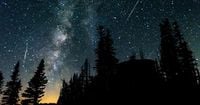For stargazers in the United Kingdom and beyond, the celestial event of the summer is reaching its grand finale. The Perseid meteor shower, a highlight on every meteor hunter’s calendar, is currently lighting up the night sky — but time is running out to catch its dazzling display. With the shower active between July 17 and August 24, 2025, the window for viewing is closing fast, making the next few nights some of the best opportunities to witness this spectacular phenomenon before it disappears for another year, according to reports from multiple local outlets and guidance from Royal Museums Greenwich.
The Perseids are renowned for their high hourly rate and the brightness of their meteors. Each year, they draw amateur astronomers and curious onlookers alike, all hoping to spot a few shooting stars streaking across the heavens. And for good reason: the Perseids rarely disappoint, offering a show that’s both visually arresting and scientifically fascinating.
But what exactly makes the Perseid meteor shower so special? According to Royal Museums Greenwich, the event is caused by debris from the comet Swift-Tuttle. As the comet approaches the Sun, it heats up and pieces break off, leaving a trail of cosmic rubble in its wake. If this debris happens to intersect with Earth’s orbit, it plunges into our atmosphere at incredible speeds — anywhere from 7 to 45 miles per second. The actual speed depends on the combined velocities of both the Earth and the incoming debris, but for the Perseids, the average meteor tears through the sky at a blistering 36 miles per second.
When that happens, the results are both beautiful and dramatic. “The air in front of the meteor is squashed and heated to thousands of degrees Celsius,” a spokesperson for Royal Museums Greenwich explained. “The smaller meteors vaporise and leave behind a bright trail of light. Larger meteors can explode as fireballs.” For those lucky enough to catch a fireball, it’s a moment that can feel almost otherworldly — a sudden, brilliant flash that briefly outshines everything else in the night sky.
Of course, not all viewing locations are created equal. Light pollution from towns and cities can dramatically reduce the number of meteors visible to the naked eye. That’s why experts and local guides recommend heading to more rural areas to maximize your chances. In the West Midlands, for example, stargazers are encouraged to travel off the beaten track. According to Go Stargazing, prime spots include Mill Pond near Birts Street, Castlemorton, and Long Compton near Chipping Norton. These locations, nestled in the more remote stretches of the Cotswolds and Herefordshire, offer darker skies and fewer distractions, allowing the spectacle to unfold in all its glory.
The Shropshire Hills Area of Outstanding Natural Beauty (AONB) is another top pick for meteor enthusiasts. With several designated Dark Sky Discovery Sites, the region is well-suited for public stargazing events and solo adventures alike. For those unable to travel far, the Clent Hills and Barr Beacon also come highly recommended. Notably, Barr Beacon holds the distinction of being the only official Dark Sky Discovery Site in the West Midlands, making it a go-to destination for anyone hoping to escape the urban glow for a few hours.
Venturing away from city lights doesn’t just improve your odds of seeing meteors; it also opens up the night sky to a host of other wonders. As Go Stargazing points out, rural locations provide better views of planets, distant constellations, and — if luck is on your side — the occasional fireball. For families, amateur astronomers, and anyone with a sense of curiosity, these outings offer a chance to reconnect with the cosmos and experience a sense of awe that’s all too rare in daily life.
But why does the Perseid shower occur at this particular time each year? The answer lies in Earth’s annual journey around the Sun. As our planet completes its orbit, it passes through the debris field left by comet Swift-Tuttle. The timing is so regular that astronomers can predict the shower’s peak with remarkable accuracy. This year, the period from July 17 to August 24 has marked the window of activity, with the greatest intensity expected in the nights leading up to the 24th.
For those planning to catch the show, a bit of preparation goes a long way. Experts recommend checking the weather forecast in advance and aiming for a clear, moonless night. Bring a blanket or reclining chair — after all, meteor watching is best enjoyed lying back and gazing upward, away from any artificial lights. Patience is key: it can take up to 20 minutes for your eyes to fully adjust to the darkness, but once they do, you’ll be rewarded with a much richer and more vivid display.
Stargazing can be a solitary pursuit, but it’s also a wonderful excuse to gather friends and family for a shared experience under the stars. Some local astronomy clubs and nature groups even organize special events around the Perseids, offering guided tours, expert talks, and the chance to swap stories with fellow enthusiasts. Whether you’re a seasoned observer or a first-time sky watcher, the sense of community and wonder is hard to beat.
Of course, not every meteor is created equal. As Royal Museums Greenwich explains, the fate of each bit of debris depends on its size and speed. Smaller particles burn up quickly, creating those fleeting streaks of light that so many find enchanting. The larger fragments, on the other hand, may survive longer and sometimes explode in a burst of brilliance — the so-called fireballs that can leave a lasting impression on all who witness them.
With the end of the Perseid meteor shower fast approaching, now is the moment to seize the opportunity. The next few nights offer the last, best chance this year to witness one of nature’s most thrilling spectacles. Whether you’re watching from a remote hillside, a quiet park, or even your own backyard, the experience is sure to be memorable. As the experts put it, the Perseids are a reminder of the beauty and mystery that still await us in the night sky — if only we take the time to look up.
So grab a blanket, find a dark spot, and keep your eyes peeled. The universe is putting on a show, and you won’t want to miss it.




